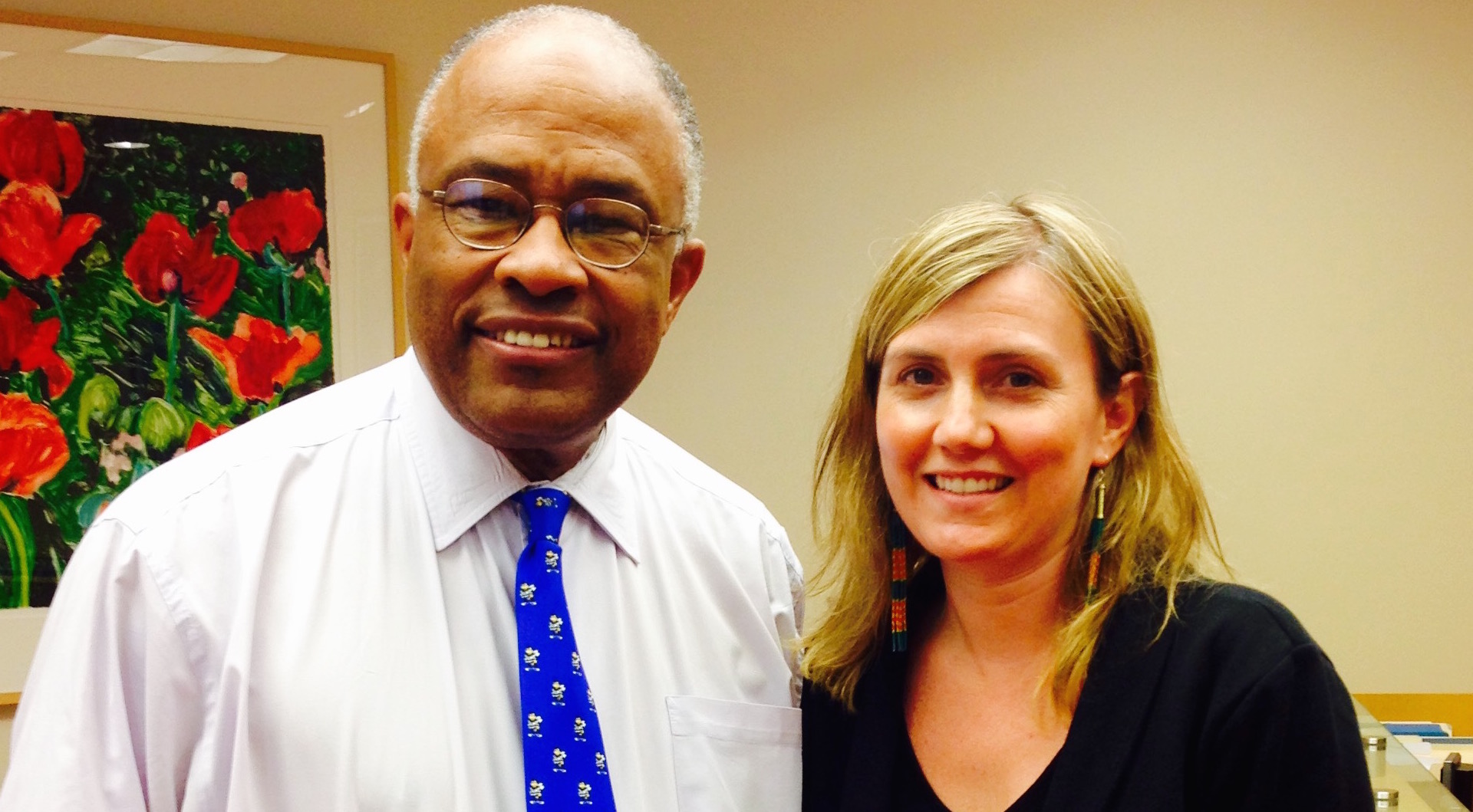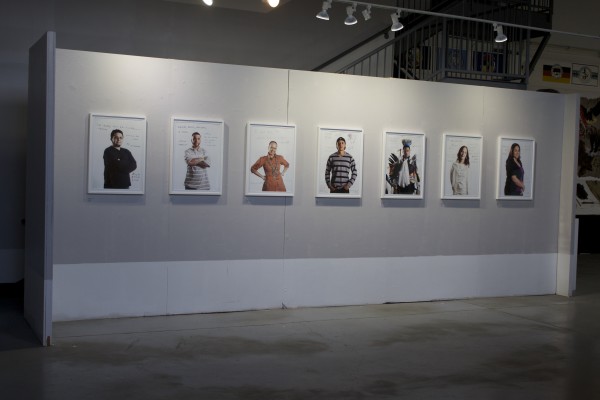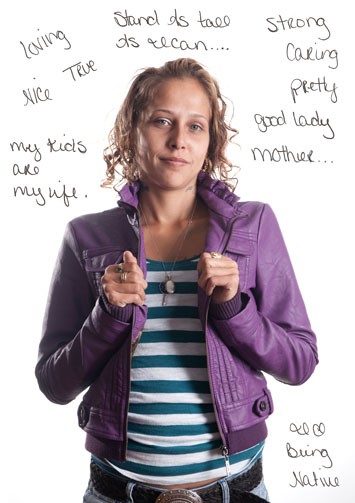An Inverview with Ashley Minner about her Exquisite Lumbee Project, currently on display at Trickster Gallery
by Cara Ober
Ashley Minner is a community based visual artist from Baltimore, Maryland. She holds a BFA in Fine Art, an MA and an MFA in Community Art, which she earned at MICA. A member of the Lumbee Tribe of North Carolina, she has been active in the Baltimore Lumbee community for many years. Her involvement in her community informs and inspires her studio practice. Ashley is currently a PhD in American Studies student at University of Maryland College Park, where she is studying vernacular art as resistance in tri-racial isolate communities of the U.S. South and Global South.

Cara Ober: Your collaboration with photographer Sean Scheidt, The Exquisite Lumbee Project, is currently on display at Trickster Gallery in Illinois through June 15th. Can you talk about how this project came about as a collaboration with Sean?
Ashley Minner: I first knew I wanted to make the Exquisite Lumbees Cadavre Esquis artist book (which is why the word “Exquisite” ended up in the title of this series… and the idea to make a Cadavre Esquis – or Exquisite Corpse – book came from this awesome artist bookmaking for kids book.) My book idea required headshots of all of the participants, front and back. A poorly lit headshot looks a lot like a mugshot, which was the complete opposite of what I was going for. A conversation with Bob Salazar helped me to realize that lighting was key. I wanted everyone to be beautifully lit, shining, looking like the superheroes that we are. I was talking with Sean about my process and he offered to take some test shots of me in his studio. We liked the way those turned out and he agreed to help me with the rest. Sean pretty much helps me whenever there is a need for technical photo skill in my work. That’s his area of expertise, not mine. We have been collaborating on projects and adventures for almost 20 years now. We’ve been close friends since high school.
CO: You are a member of the Lumbee tribe and are originally from Baltimore, right? Can you give a brief history of the tribe and how many of its members migrated to Baltimore from North* Carolina?
AM: Right. Thousands of men, women, and children of all nationalities and races propelled Baltimore into the Industrial Age. After the second World War, there too was a large migration of Lumbee Indians from rural North Carolina to Baltimore City. Like other groups, the Lumbee came seeking employment in order to improve their quality of life. They settled in Southeast Baltimore, concentrated in a 64-block area from Broadway Street to Patterson Park. This became and remains to be the largest Lumbee community outside of Lumbee tribal territory in existence. With them, these Lumbee brought their culture and traditions, which they have kept and shared in Baltimore over the years. The grandparents of most of the people in the Exquisite Lumbees series were part of this first wave of Lumbees to move to Baltimore.
CO: Can you talk about your own experience of being a Native American in a country filled with misinformation about the history of our ancestors? Do you consider your perspective on the United States different than many other more ‘mainstream’ Americans?
AM: Well, to justify the United States occupation of this land, Native Americans exist as a “permanent absence” in the dominant, collective American psyche. If the myth persists that there are no natives, no one has to reckon with what happened here since contact. So, when I explain to people that I’m Indian, I get the funniest reactions. People guess that I am everything but what I am. I get Puerto Rican or Dominican most often. Lots of people think that all Indians should look like Hollywood Indians. In reality, and in this day and age more than ever, Indians run the gamut of skin colors, eye colors, hair textures, etc. It took me a long time just to feel comfortable in my Indian identity and in my own skin. I feel that I should also acknowledge that my dad is white, of Swiss ancestry. I’m proud of that side too. (smile)
CO: After earning an MFA in Community Art from MICA, you are now enrolled in a PhD Program at UMCP in American Studies. Why did you want to pursue an advanced degree and what are you currently studying? What is your ultimate career goal as an artist and scholar?
AM: I find that I am able to speak on a variety of social justice issues with the knowledge of my life experiences (and my art is one way to use my voice). And I’ve noticed that, for whatever stupid reason, people get a lot more respect, attention and funding from certain circles when they have some letters attached to their name. I just finished up my first year of the program. It is an incredible learning process in which I feel very blessed to participate. It’s hard, but I’m enjoying it. At the end of the day, for me, it’s about having increased knowledge and capacity to leverage more resources for more people… and it’s about having a voice in arenas where people like me are underrepresented and being researched instead of doing the researching. I want to keep doing what I’m doing and expand what I’m able to do. I don’t want to be a professor, but the idea of being a public intellectual is appealing. To be clear, I don’t think you have to go to school to be smart or to be an artist. Some of the smartest people I know can’t read or write. But if you go to school, you can speak to power from a different level.
CO: The Exquisite Lumbee Project has been exhibited in Baltimore and is traveling to other spaces across the country. It comes across as contemporary photography and also narrative research … especially in the way image and text are combined. Can you talk about this process and also how you and Sean decided on the simple and clean aesthetics of the images?
AM: It’s been shown all over Baltimore and was just recently loaned to the University of North Carolina at Pembroke Department of Southeast Indian Studies, where it lives for the time being. This is hugely significant to the project and to us because UNCP is the school that Lumbee people made for themselves. It is our tribal college from the days of racial segregation (that has since become part of the University of North Carolina system). I borrowed the series back to show it at Trickster in Illinois. Everyone who made a portrait was given a copy of their portrait, so really I’m just showing a portion of the work- whichever portraits were made in multiples back in 2011. There are 30 portraits in the series. I’m showing 11 in this iteration.
About the white backgrounds- we definitely wanted to privilege the subjects in the portraits. I knew I wanted white backgrounds to accomplish that and to be a ground for the text written by the subjects. Sean is a master of lighting. He worked out the rest.
CO: The process of collaboration seems to be central to your practice and your vision as an artist. What does collaboration mean to you? Why is it important and what has it taught you?
AM: I try to use my art to elevate or amplify the beauty and preciousness of people. This involves engaging them in their own beauty and preciousness and in their expression of it. I am also a firm believer in good craft. If my work requires a technical expertise that I don’t possess, it makes sense to collaborate with someone who can help make the work the best it can be.


Author Cara Ober is Founding Editor at BmoreArt.
Upcoming: Ashley Minner’s work will be exhibited in the solo exhibition trace from July 3 – August 29 at The Delaplaine Center in Frederick, MD.























